Russian Virtual Computer Museum. → Hall of Fame → Mark Valeryanovich Tyapkin
Mark Valeryanovich Tyapkin
“The life inseparable from IPMCE”
by Alexander Nitusov
Text of the article was revised, corrected and approved by Dr: M.V. Tyapkin himself.
When one is watching a ship, he can see the captain, mate, steersman but never a mechanician, although the ship can hardly move without his work.
It is with him, the first (and oldest) designer of the components and systems for all digital computers invented and developed by academician Sergey Lebedev – Dr. Mark Valeryanovich Tyapkin could be compared.
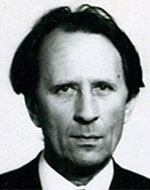
Mark Tyapkin
Doctor of Technical Sciences[1] Mark Valeryanovich Tyapkin, veteran of the USSR computer science and engineering, was born in Moscow on the 25th of December 1927.
His parents originated from the towns of Orel and Kursk (in West Russia), but soon after marriage resettled to Moscow where they received education. The father studied economics and the mother, highly intelligent person, graduated from so-called “Institute for Noble Maids”. As she perfectly mastered German and French languages and was also good at English, she worked as an interpreter and librarian at the State Trade Chamber.
Mark was the only child in the family. He lived with his mother and nanny in the center of the city; he saw his father very seldom. The school №330, where he studied, was just next door to their house. It was an old one founded long before the October Revolution (1917). It also maintained some of its old -original- traditions. Mark remembered that old-fashioned building and assembly hall with a niche, with the model of the school building in its original form. Mark himself was interested in radio, he was fond of making models and once assembled complicated operating model of a turbine. However, in general he was an ordinary active boy, “very interested in “explosioning” “, on his own comment.
The war
When the war broke out Mark was 14. The father joined the army went to front and never returned home again. Life was very hard at those times. The mother had to change her former working place for position of a chatelaine at a military hospital, luckily it was near their house. Mark graduated from the 8th form at school, and entered the Power College (or Energy College) working in parallel as an errand boy. “At least, received worker's card and a dinner of soup with it”. That was his basic food ration; “Anyway, I was always hungry, however, that minimal food provided some powers”.
“One day, in the middle of the war time, the mother changed her suing machine for ten kilograms of potatoes. We couldn't resist and cooked three potatoes for three of us”. “That was a glorious dinner, which I remember until now”, says Dr. Tyapkin. “Luckily, I was very young then and didn't realize that it was real hunger”, he comments on. “I simply always wanted to have something to eat”.
Moscow Power Engineering Institute and the first experience with electronic computers.
After graduation of the college in 1946, Mark entered special training courses to prepare for entering exams to the Moscow Power Engineering Institute (MPEI – technical university). In 1947 he successfully passed all exams and became a student at the faculty of Electro-Mechanics. When Tyapkin was at the fourth university year a new special subject was introduced, “Calculating Machines”. Academician Sergey Alexeevich Lebedev was the lecturer. He told the students about inner structure of a computer, the logic of its units' functioning, its components, about binary arithmetics and foundations of programming.
However, the first contacts with real computers didn't look too romantic. The faculty received a directive to dispatch six students to the Institute of Precession Mechanics and Computer Engineering (IPMCE) to do practical works before writing diplomas/for a degree/. That should be done at the IPMCE electronic computers laboratory, about which the students had little idea.
Years later the laboratory (“S.A. Lebedev's Laboratory №1”) would be world famous, but not then, ... “We simply received its address – namely IPMCE, and when I got there I was immediately involved in its work. They asked me to assemble and solder a trigger unit (flip-flop) – the basic component of computer”, remembered Tyapkin.
Notably, once getting there, almost all MPEI students-trainees remained at the IPMCE for their whole lives. Among them there were Vsevolod Burtsev, Andrey Sokolov, Valeriy Laut[2], etc. Design and modeling of some unit for BESM computer was a diploma subject for each of them. BESM was the USSR first big computer and the idea of engaging the students into design of its units – “collective design” belonged to Sergey Lebedev himself.
Their diplomas were presented and defended at the IPMCE. As the computers were widely implemented for solving various defense problems some works on BESM were classified, therefore specially formed scientific commission on diplomas/degrees arrived there from the MPEI.
Mark Tyapkin graduated in 1952, as engineer on “automatic and measuring systems” and was given appropriate position (or rather, remained at it) at the IPMCE, where he is still working (2016) at his “traditional” place!
By that time Lebedev had already completed his first (the first in the Continental Europe) electronic computer MESM[3] in Kiev and moved to Moscow, where he started new project on a big digital electronic computer, officially named “BESM of the USSR Academy of Sciences”.
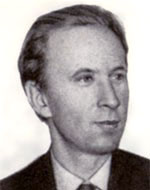
M.V. Tyapkin
Tyapkin's first task at the IPMCE consisted in assembling a trigger (flip-flop) unit according to a printed layout. “I was given a soldering work”, commented Tyapkin. The upper board of the unit carried four smaller panels with electron tubes: two for triode tubes and two for diode tubes. The lower board had two connectors for contact with computer's integrating board. Resistors and capacitors should be connected -soldered- to contacts of the tube panels and the connector. Some of them were connected just to each other, without support – “in the air”. However, such structure became stable and reliable. In fact the work was done very well, nevertheless, it turned out to be impossible to draw all that trigger circuit on paper. The institute had already established department which prepared documentation for manufacturing plants (although a compliance assessment was not yet introduced) but making such drawings needed enormous time. For that reason, the ready made trigger units themselves were handed over to the plant instead of drawings. Using that model, the plant's professionals easily manufactured all necessary triggers (flip-flops) for the computer “BESM of the USSR Academy of Sciences”. Tyapkin's amateur experience in radio helped him to do rational, high quality devices. One could even claim that computer BESM was assembled with, or rather based on, “Tyapkin's trigger units”.
Computer BESM created principally new possibilities for the institute's scientists in solving various problems. From the very beginning of its testing operation the first programs imitating human intellectual activity were produced in parallel with purely computational (mathematical) programs. Thus, for example, chess program solved two- and three-steps problems much quicker than the institute's chess champions.
The first experiments in automated translation from one language into another one also brought promising results. Of course, those were only experimental interlinear translations far from being suitable for practical implementations, however, they were generally satisfactory (here the reader can see it: https://www.youtube.com/watch?v=G1x5luIneNg).
The engineers who were working with BESM produced and played simple logic games with it (oughts and crosses). Most probably those were the USSR first computer games.
Even more important was the scientific and engineering team, which had formed itself at the IPMCE while designing the first electronic computer. The team consisted of young engineers fanatically devoted to computers and computing; that was both their work and their hobby (V.N. Laut). V. Laut and A. Sokolov became Tyapkin's best friends. Since then they always worked together, many years. They also spent much time together: “Celebrated Christmas together”.
Life at the IPMCE
Soon, young MPEI graduates were fully involved in the world of institute's professional and social life. Everything was impressive; the new institute building was surrounded with parcels of empty land – then the research center location was almost the edge of Moscow. In a way that was an advantage – due to abundance of free place improvised tennis courts and other sport grounds were quickly arranged by the younger institute collaborators. Those at once became very popular, later they were transformed into permanent sports complex. All that formed stable sports traditions at the institute.
Everybody also remembered overcrowded buses, that were the only public transport linking the IPMCE with the nearest metro station. Those bus trips were not always “merry adventures”, especially because of the very rigorous institute's work schedule.
Academician S.A. Lebedev himself was always very attentive to young collaborators, therefore, Mark Tyapkin and other newcomers immediately received not only work tasks but also the salaries, which seemed to be almost a rain of gold, in comparison with the university's scholarships.
The most popular place/way of its spending was the canteen of the neighboring Directorate of the USSR Trade Unions Central Council – the only building not too far.
As soon as the lunch-break started one should came running there as quickly as possible, to get a remaining free place at some table. That provided comfortable lunch; those times the meals were served by (young) waitresses. Monitoring from behind a corner (rather, all available corners) the moment of a time when controlling woman appeared at the entering doors (beginning of the lunch break) with the following “hungry races” (to the canteen) became one more of merry adventures of “the new life”.
All that made the institute's life more vivid, however, the computers were not only the most attractive, exciting issue, but the most important professional factor. All scientists, both young and not, were fascinated with extraordinary intensive creative atmosphere, rapid growth of the general scientific competence level and sincere, very friendly relations between the colleagues[4].
Many years after, those relations still remained “same as 'at the student times' ”, totally free from enviousness, rivalry or “scientific filthy lucre”.
“We were neither interested in official scientific degrees nor in writing dissertations, just worked because it was interesting”, commented Tyapkin, briefly as usual.
The First Experience
As Mark Tyapkin was one of the first IPMCE collaborators he took part in almost all Lebedev's projects. Design of magnetic drum /memory unit/ for the BESM computer was his first individual work. Several hundreds of reading heads were mounted on the drum; it was unrealistic to provide each of them with an own amplifier. Tyapkin proposed simple and reliable solution – he implemented common multiplexor/commutator, which automatically selected actual commutation objects. Electron tube diodes were its basic components, which, among other advantages, did not suffer from overheating (the scourge of electronic tubes of those times).
When the computer was put in full operation Tyapkin continued with its maintenance. Limited work time of the electron tubes caused the need in frequent repairs (replacing tubes). Although the computer was in round o'clock operation its efficiency never exceeded 70%, the rest 30% were left for repairs. Failures could (and did) happen several times a day and an interval between them sometimes was less than an hour. 18 hours of uninterrupted operation was the absolute record!
The reason of that was not only (if, at all) in low quality of the tubes themselves, of their composing materials, etc. Then, at the beginning of computer engineering and manufacturing, practical – technological experience was rather miserable. Thus, design of power supply units was “not perfect”. For example, computer TsEM-2, which, a little later, was designed and assembled at the Institute of Atomic Energy, operated uninterruptedly weeks long. Specific feature of the TsEM-2 (and main idea of its designers) consisted in increasing stability of the tubes' power supply system; the signals it generated should have most possibly “clean” and correct form of curves (especially with minimum faults in transient response curves).
Quite naturally, Lebedev's engineers were constantly controlling BESM. Tyapkin commented: “Soon we abandoned all layouts and other documents; although the computer had several thousand tubes we quickly learned them all by heart and knew the weak points without any drawings”.
Mark Tyapkin was decorated with the order “Red Banner of Labour” for his contribution to design the “BESM of the USSR Academy of Sciences”.
Competition with STRELA
S.A. Lebedev was recognised computer pioneer, and the progress of his works was obvious. However, activity of other computer scientists' and of research and production centres' was also increasing.
While Lebedev's IPMCE was working on its BESM, powerful research and production complex – Special Design Bureau 245 (legendary SDB-245), which also integrated well established and rather powerful plant for Computation and Analytical Machines (CAM), produced its own computer STRELA. That was the first serially manufactured computer in the USSR.
Digital electronic computer STRELA
STRELA had some advantages in comparison with BESM. Its information output unit was a typing device with broad paper tape. That provided high speed of data output – one could read them from paper at once. Data output in BESM was performed by special device with argon point-source lamps board, which exposed output information on film strips/rolls.
The device itself operated efficiently, the problem was in the (photo)-film development and -especially- in long-lasting subsequent drying, which was, in fact, the main cause of the slowness.
Engineers of the IPMCE found more than unusual solution – they took a pail of alcohol and dipped there developed wet film. After that it dried in no time and all inventors of “new technology” were happy. Actually, speed of the data output rose sharply.
Of course, there were also other differences. As a result of the “competition”, administration of the USSR Ministry of Instrument-Making made decision to produce one more -the third- computer by joint efforts of the both organisations: IPMCE and SDB-245.
Digital electronic computer M-20
New computer was M-20, its design was performed by the IPMCE. All its components were of the most advanced type, for that time. Thus, there were electron tubes based dynamic flip-flops (triggers), which gated (or not) series/flows of electrical impulses characterized with relative duration. That was the difference between them and static flip-flops (triggers), which had only two stable states: “off”- no signal and “on” - constant signal; there was also combination logic performed on semiconductor diodes.
Two computers M-20 had been manufactured as experimental pieces, without any exterior trimming; one was assembled at the IPMCE itself, where its testing and adjustment were performed, the other M-20 was given to the SDB-245, but nothing was done with it there, they only waited to get ready results from the partners (IPMCE).
The SDB-245 quarters were housed at the computer manufacturing plant's site (CAM). Mark Tyapkin went there to design magnetic tape storage device, but when the work was completed he remained to develop control system for external devices of the M-20.
The beginning of testing and adjustments works was not successful at the IPMCE. Computer operation was neither stable nor reliable, because of the numerous failures constantly taking place. A conflict was arising between the partners. SDB-245 administration sent complaint letters to the ministry. Then S.A. Lebedev summoned M. Tyapkin, A. Sokolov and V. Laut and said; “Well, youngsters. Get in”. So they did.
Technical analysis performed by them displayed two main reasons of the computer's low reliability. The first one consisted in usage of delay lines for organisation of dynamic triggers' computation inputs. As the good matching of delay line output (signal) with trigger during the work on non-linear load was impossible to realize, the reflected impulses interfered with the trigger's normal work.
One more reason or low reliability was big delay times spread between different lines. When they dismissed the lines and changed them with additional diode logics, the triggers' (flip´flops) reliability increased greatly and the needed level was reached.
The second reason of the computers (BESM) low operation reliability consisted in multistep system of synchronous signals distribution among the computer's units. That was caused with usage of amplifying components which had relatively low load capacity. Result of the multistep structure was a scatter of times of synchronization signals appearance in different units of the computer, what led to drop of reliability in signals exchange between those units.
To eliminate that phenomenon designers developed powerful amplifier for synchronous signals, which increased load capacity. Implementation of the amplifier made possible two-step signals distribution in the computer. One central amplifier was sending signals to all computer boards, others – one on each board, distributed synchronization signals among all users.
Introduced “two-step mode” drastically reduced dispersion of arriving the synchronization signals to different boards; it also provided necessary level of inter-board links operation reliability.
As the changes-improvements- in dynamic triggers (flip-flops) and the synchronization signals circuits affected just a small part of the computer's circuits, the main structure of M-20 and all its basic circuitry remained untouched - the computer was in full operation mode within a couple of months. And the discussion about its serial production followed immediately. It worths mentioning that the delay in the beginning of its serial manufacturing led to the “forced prolonging the BESM's life”.
Those times, one of the reasons of that -may be indirect one- was “low public awareness, of computer-related problems”. Even among quite competent technical and scientific workers. Thus, at the beginning of the BESM project there was a solid opinion that only one peace of such “powerful” computing machine would be enough for all scientific needs. Therefore, only sketch drawings were used for its design and development, which were later simply disposed of. Its components also were mainly not intended for serial production.
Besides of that, both design and manufacturing could be performed only upon official permission from administration (as a rule, from responsible ministerial headquarters). However, most of the officials (even the “benevolent ones”) simply did not understand importance and perspectives of the new computing machinery and related technologies.
Academician Sergey Lebedev himself told about an official from “higher places” (a “big boss”), who once dropped the following phrase: “Well, suppose you'll get all the money you need, make the computer which will quickly solve all your problems, and what will you do with it after that?”. “You will throw it away?”.
In fact, what could one expect from a bureaucrat when even most of the engineers of those times didn't have the slightest idea about computers (see above). Nevertheless, already by the moment of the BESM testing completion it was clear that there was need in -at least- several dozens of such computers. However, restoring design documentary of the BESM already made no sense because resolution of M-20 manufacturing had been already adopted. Elements of the computer M-20 structure (cabinets, boards, cells) were designed at the SDB-245, its electronic components and all kinds of electrical links were designed by the IPMCE. Mark Tyapkin and his colleague from the IPMCE were also working with a magnetic tape storage – they designed its electronic part; mechanical part was done by engineers of SDB-245. The memory device transported 35mm tape from one closed receiver (“well”) into the other one. For that reason the tape sizes were limited: 8 lanes, plus two reserve ones made possible recording of 300 000 codes of numbers with 45 places, what made approximately 37 Kbyte altogether.
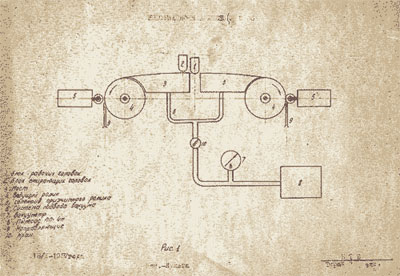
Computer M-20: “Memory storage device with magnetic tape, using tape transport mechanism with rarefaction of the air for maintaining the tape tension”.
Designers: V.S. Klepinin, M.V. Tyapkin, Y.R. Valashek.
SDB 245: Information bulletin №36. (M. Typkin's private archive)
Generally speaking, Tyapkin's team “stuffed” structure of M-20 with electronics from the “BESM AS USSR”. V.A. Melnikov was also engaged in that works both as technical supervisor (from authoring group) and engineering trainee himself.
That work was performed within few months. As a result, serial production of M-20 and BESM-2 (serial model to follow BESM) started practically simultaneously. Although performance of M-20 (20 000 ops) was twice as high as the BESM-2 (10 thousands ops) serial manufacturing of BESM-2 noticeably reduced “computation hunger” in the country.
It's interesting to mention that BESM-2 was the prototype for the first big computer in China, named BESM-K (with official title “The Quickest Computer in Asia”).
BESM-2 was the free choice of Chinese experts, because the both computers had been first demonstrated to them. Before making improved copy of it in Peking (Peking Institute of Computer Engineering) a big group of Chinese engineers studied and trained at the IPMCE. All documents, layouts, etc. were given to the Peking institute, as well as all electronic components, which were not yet produced in China at that period (their production started after beginning of the works on BESM). Five engineers of IPMCE several years worked in turns in China; they lectured, performed technical and scientific supervision and participated in practical works together with the Chinese colleagues. One of them, was Oleg Shcherbakov[5] – an expert on power supply systems (later, the IPMCE senior scientific collaborator; he worked there until the age of 90). Shcherbakov remembered, “Chinese colleagues treated us really better then brothers, however, we all worked 25 hours a day. We wanted to help.” Melnikov was the head of the Soviet expert team.
Computers М-20 and BESM-2 were the last universal (not special-purpose) computers of the IPMCE based on electronic tubes. There came the time of transistors.
BESM-6
The first transistor-based computer designed at the IPMCE was made for defense (army) purposes. By that time two computer laboratories had been already established at the institute. One designed universal (“civil”) machines, and the other one was engaged in special purpose computers (mainly military) research and production.
Sergey Lebedev charged the first laboratory with creation of the central computing unit. He appointed personally Tyapkin, Laut and Sokolov to be the responsible designers. The second laboratory produced control systems both for the computer itself and for the whole field of its peripheral devices.
World-famous computer BESM-6
As Lebedev always wanted to achieve possible maximum computer performance (realistic for technology level of that time), the young designers started making the components able to provide maximal possible operational frequency. Thus, the diode logic, which proved its high efficiency in M-20, was preserved. Electronic tubes amplifiers were replaced with transistor ones. They were connected in “current switch” circuit. Main idea consisted in unusual solution on conditioning of input and output signals levels. Miniature “individual” power sources were introduced into circuits between collector of each transistor in the current switch and its load resistor. Especially small sizes of the power sources were obtained due to implementation of high frequency in their operation, which reached 400 kHz. Transformers of those sources were made on small ferrite rings.
Due to individual power sources amplitude of output voltage became practically independent of the computer components' parameters spread. That, in its turn, made possible to minimize amplitude of output signals, what provided high frequency of the computer components operation in general.
Special arithmetic device, processing numbers with floating point, was designed for control of the system of components operational ability. Testing demonstrated its high reliability and performance.
At the same time, one of S.A. Lebedev's closest assistants, Vsevolod Burtsev chief of laboratory №2, persuaded military customers that computer which processed numbers with fixed-point matched their problems much better. He reasoned with essentially important circumstance – fixed-point processing enabled machine-check of almost all computer units. That significantly increased certainty/authenticity of problems solution results. Burtsev proposed the customers to use the central computation unit, developed at his laboratory but the central computing unit of the laboratory №1 remained of no demand. Nevertheless, S.A. Lebedev realized that computer with floating point was necessary for the broad spectrum of scientific-research and engineering problems. He decided to make such computer upon the central computing unit of the laboratory №1.
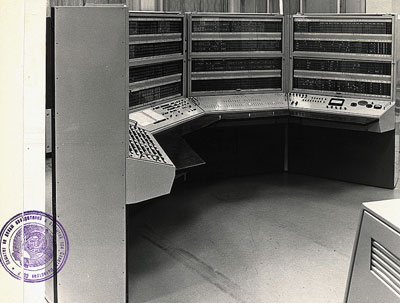
BESM-6. The central part.
(photo from M.V. Tyapkin's “Author's Invention Certificate” No 1739)
(M.V. Tyapkin's private archive)
That computer was named BESM-6. Design team was extended with some other laboratory collaborators. Also the system of peripheral devices control was improved. A. Sokolov led the design and adjustment of external memory (ROM) on magnetic drums; M. Tyapkin headed works on ROM on magnetic tapes. The computer was provided with wide range of other peripheral devices (printers, input-output of data punched cards, perforated tapes, etc.). Tyapkin used 19 mm tape from M-20, with 10 lanes (8-main ones), for which he devised new servo system to tape feeding drive control. At the same time the computer plant CAM/SAM/ - SDB-245 implemented more broad tape – 35 mm, similar to American tapes of that time. However, the BESM-6 designers remained with the 19 mm tape (later, most of computers were equipped with the 35 mm tape). Tyapkin also worked with BESM-6 arithmetic device.
BESM-6; the central part
In 1967 BESM-6 successfully passed all tests of the State Commission; its following serial production lasted more than 15 years. M.V. Tyapkin with some other colleagues were awarded “the USSR State Premium” for scientific contribution to that project.
Academician Sergey Lebedev and colleagues, celebrating the BESM-6 “inauguration”
(very famous photo)
The BESM-6 remains in the history of science as “one of the miracles of computer engineering”. Everybody who worked with it admired its high reliability and perfection of its design. At least one BESM-6 was still in operation in the Leningrad area, in the year 2013.
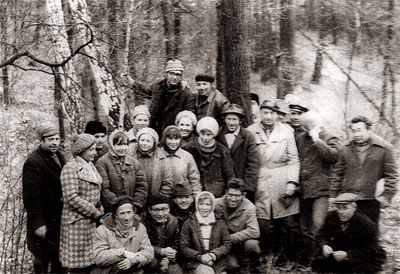
IPMCE collaborators “loading cabbages” - action of assistance to partner agricultural enterprise.
M.V. Tyapkin (sitting) – first on the left, O.K. Shcherbakov (staying) third from the right.
(Photo from M.V. Tyapkin's private archive)
The ELBRUS Family
Performance of BESM-6 reached 1 mio ops – that time it was an advanced characteristic; however, some few years later the institute was facing the need in computation system with performance 100 mio ops. Two projects were worked out by the IPMCE for solving that problem. Those times it was impossible to produce a single processor with such performance. Therefore, both projects planned design of the processor with performance 10 mio ops, with the following integration of ten such processors into joined multiprocessor system.
Laboratory №1 proposed the further development of BESM-6, it was named BESM-10. Its operation was based on diode logic and transistor amplifiers made as hybrid microcircuits of transistors' inner parts. The project was actively supported (among others) by academician Y.B. Khariton[6], who was conducting researches in nuclear physics; Khariton was also a representative of the USSR Ministry of Middle Industry (very influential one, responsible for atom projects).
Of course, the main reason of Khariton's interest was the impressive amount of BESM-6 ready programs accumulated during its usage.
The project of laboratory №2 was based on usage of big integrated microcircuits (BIC) and integrated microcircuits of IS-100 (ИС-100) series. That project named ELBRUS[7] (Эльбрус) was actively supported by the army customers; V.S. Burtsev always maintained close relations with military circles.
Both projects were expensive and labour-consuming; BESM-10 project was closed and all efforts concentrated on ELBRUS, purely on economical grounds.
Generally speaking, the idea of supercomputer (as most of the scientific ideas) had been first set forth by S.A. Lebedev. However, that time – the beginning of the 1970s- he was already ill (cardiological problems), and the basic leadership both at the institute and at the ELBRUS project passed to Burtsev, who became the IPMCE director and the chief designer of ELBRUS.
Taking the interests of “nuclear experts” under consideration, Burtsev implemented in ELBRUS the central processor emulating and supporting BESM-6 system of statements. The processor was named SCS (СВС) – Special-processor of Computation System.
The task of its designing Burtsev trusted to M.V. Tyapkin and his team. At the beginning designers named it, for some unclear reason, not ELBRUS but CHEGET (also a summit on Caucasus). Processor SCS (also SCS-1) was often mentioned as belonging to CHEGET (there should be no confusion), however, later in official documents it was referred to as a part of ELBRUS.
M.V. Tyapkin says, “The process of ELBRUS development one could reasonably name “two-phase one” - first, there came “Slow ELBRUS” (ELBRUS-1, and after that “the Quick one – ELBRUS-2”». (Like two summits of real ELBRUS – smaller and higher ones(A.N.))
Digital electronic supercomputer ELBRUS (control boards)
Although SVS/СВС/ was intended only for usage in Multi-machine Computing Complex (MCC) ELBRUS-1 (МВК Эльбрус-1), its components were similar to the central processor components of the next computer ELBRUS-2 (Эльбрус-2); the big integrated microcircuits (BIM) were the only exception in that case, because technology of their manufacturing was not yet implemented in mass production in the USSR, by that time. That way of development made possible “refining” of the MCC ELBRUS-2 central processor before the beginning of its manufacturing. In 1980 SVS (as a part of MCC ELBRUS-1 complex) passed all tests of the State Commission and demonstrated 2-3 times higher performance than BESM-6. MCC ELBRUS-1 with processor SVS was mainly produced as a single-processor computer under special name MCC ELBRUS-1-K2 (complex 2), however, also as double-processor MCC ELBRUS-1-K4 (complex 4). The latter complex was used at the control center of the Soviet satellite navigation system GLANAS.
Dr. M.V. Tyapkin and some other colleagues from the IPMCE were decorated with the orders “Red Banner of Labour”, for their contribution to design of MCC ELBRUS.
Architecture of MultiMachine Computing Complex ELBRUS (МВК “Эльбрус”) was intended for organization of very big computation complexes (up to 10 central processors, plus processors for data input-output). However, in case of forming small complexes, abundance of hardware was senseless, it caused unreasonable financial losses and unnecessary large size.
In this connection, in 1986 new IPMCE director, Dr. G.G. Ryabov, who was appointed after academician V.S. Burtsev, charged M.V. Tyapkin and his team with design of new computing complex, compatible with BESM-6, but more economical than ELBRUS-1 with processor SVS /CBC/. That new complex was named ELBRUS-1-KB (where K means “Komplex/complex” and B stood for relation with “BESM-6”. The specialists between themselves commonly named it “Integrated BESM”.
That computer/complex was very “moderate” in size. Its central units were housed in two standard-size cabinets of ELBRUS-2. Operating memory unit (64 Mbyte) was in one of them: The other one contained processor unit, data input-output channels, and two duplex broadband 64-places channels, which made possible to join up to four ELBRUS-1-KBs (also E1-KB) into a single computation complex.
Most of its peripheral devices were joined to the central part. E1-KB successfully passed all tests performed by the State Commission in 1988; it demonstrated performance 4 to 6 times higher then BESM-6.
More then 60 such computers were produced within the period from 1988 till 1992. In 1991 design team of E1-KB headed by M.V. Tyapkin was awarded the “Premium of the USSR Council of Ministers”.
In 1987 Mark Valeryanovich Tyapkin was awarded scientific degree “Doctor of Technical Sciences”; he did not write/submit a thesis because he received the degree for the total of previous works and developments, that was much more formidable then any dissertation.
In 1989 M.V. Tyapkin was awarded “S.A. Lebedev Premium” by the Academy of Sciences Ukraine – “for achievements in computer science and engineering development”.
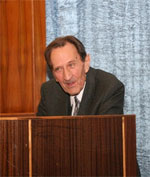
Dr. M.V. Tyapkin at the IPMCE at the ceremonial meeting on the occasion of his 80 years jubilee.
Tyapkin is a very modest and friendly man, with not a single trace of selfish ambitions or arrogance, both in his communications with friends/colleagues and in private life. These are his personal traits and qualities.
Although... one can say that Tyapkin is “extremely ambitious”, but it manifests itself not in a pursuit of vanity but in “pursuit of quality” - “it's shameful to flake on work” (Tyapkin is laconic as usual). His scientific work is the sense of his life and in a free time/vocations he always likes, “To travel to the South with family, by car”.
With the beginning of the 1990-ties (the “new life”) the IPMCE entered period of depression. From 1995 the laboratory where he is working performs joint projects with maritime scientific and manufacturing structure “Horizon” (town of Rostov on Don). His team is developing special computers for processing various flows of signals.
Currently Mark Valeryanovich Tyapkin is still working at his institute, as usual.
Sometimes, when he falls ill he cures himself in very radical way: “Going to work...”.
Sources:
- Interview with M.V. Tyapkin.
- M.V. Tyapkin's private archive.
- Materials of the Virtual Computer Museum (www.computer-museum.ru)
- M.V. Tyapkin's certificates of the author's rights (Авторские свидетельства)
Notices.
1. The Russian Doctor of Science degree is the highest research degree in the country. It is essentially higher than Doctoral degree in English speaking countries. Many scientists having that degree are professors.
2. Prof. Dr. Valery Nazarovich Laut – M.V. Tyapkin's colleague and friend, famous computer designer. He was born in Ukraine, in 1929. Together with Tyapkin performed testing and adjustment of the “BESM of the AS USSR”, during their practical works at the IPMCE for diploma preparation. Upon graduation from the MPEI in 1952, he remained there as an engineer. In 1958 V. Laut received his first scientific degree (“Candidate of Technical Sciences”). In 1968 he was appointed as the head of an institute's department. In 1981 successfully defended dissertation for “Doctor of Technical Sciences” degree, and in 1986 received professorship.
V. Laut participated in design of computers BESM, M-20 and the world-famous BESM-6. Later, he developed memory devices at the V.S. Burtsev's department. V. Laut – recognised expert at computer semiconductor storage units. He was one of the supercomputers ELBRUS-1 and ELBRUS-2 designers.In 1969 he was awarded the “USSR State Premium” (as a member of BESM-6 leading designers team). He is also decorated with orders of “Red Banner of Labour” (1956, participation in design of the “BESM of the AS USSR”), “Friendship of Peoples” (1982, ELBRUS-1), order of “October Revolution” (1988) and the medal “For Valorous Labour” (1970).
3. Computer M-1(ЭВМ М-1) designed/ produced by the team of academician I.S. Bruk, at the “Power Institute” AS USSR in Moscow, was officially accepted by the State Commission several days before accepting of S.A.Lebedev's MESM in Kiev (A.N.)
4. Descriptions of the “life and customs” at their laboratory one can also find in the articles: Lebedev Sergey Alekseevich and Sokolov Andrey Andreevich.
5. Oleg Konstantinovich Shcherbakov – (degree “Candidate of Technical Sciences”, senior scientific collaborator of the IPMCE), honourable veteran of the city of Moscow (a title of honour) – co-designer (power supply systems) of the computers “BESM AS USSR”, BESM-2, M-20, BESM-6, PIKO, PIKO-V, PIKO-M and BESM-K (the first big computer in China).
Veteran of the WWII. Decorated with orders “Patriotic War” (II degree), “Red Banner of Labour” and 19 different medals.
6. More on Khariton Yulii Borisovich - https://en.wikipedia.org/wiki/Yulii_Borisovich_Khariton
7. Mount Elbrus is the Europe highest summit, in the North Caucasus (https://en.wikipedia.org/wiki/Mount_Elbrus); amateur mountaineering and traveling were very popular in the USSR, that's the reason of many “geographical names” in the Soviet engineering.



